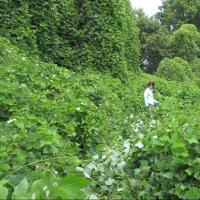Surviving the Invasive Plants Apocalypse with Citizen Science Apps

If you’re like two-thirds of smartphone users, chances are you tend to spend at least an hour a day, on average, on mobile apps like news, sports, gaming, and entertainment. How about a worthy addition to your app library? Mobile apps can be tools that let citizen scientists help researchers collect data on invasive plants that are destroying our ecosystem.
There are more than 6,500 invasive species in the United States, causing more than a hundred billion dollars in damage each year to the US economy, according to the United States Geological Survey, a scientific goverment agency. These nonnative organisms can threaten native animals and plants. While ivy-covered halls sound charming, in reality battling English ivy, kudzu, or Chinese privet in the landscape is akin to trying to fend off a hostile plant-based apocalypse of rapidly spreading invasives.
As part of the battle, these citizen science apps help experts track invasive plants.
While enjoying America's national forest system, keep an eye out for invasive species and help researchers map invasive species using the Wild Spotter app on your smartphone or other mobile device. To identify which plants are invasive, check out What to Look For. This is a collaborative project of the University of Georgia, Wildlife Forever, the USDA Forest Service, and others.
In Washington state, report an invasive species, plant or animal, by collecting photographs, geographic coordinates, and sighting information, and submit sightings, via the Washington Invasives iOS or Android app.
For more information and additional resources, Bugwood Apps from the Center for Invasive Species and Ecosystem Health at the University of Georgia is a roundup of apps from across the country, like the EDDMapS Pro app for reporting invasive species.
And if you’re looking for better planting choices for attracting butterflies and birds, here’s a work-in-progress Native Plant Finder, ranked by the number of butterfly and moth species that use them as host plants for their caterpillars. This project is based on the research of Doug Tallamy, professor of Entomology and Wildlife Ecology at the University of Delaware.
Finally, if you’re unsure if what you’re considering planting this spring has any plant-zombie potential, save yourself some trouble and click on the US Department of Agriculture invasive species profiles to find out what plants are invasive in your area.

